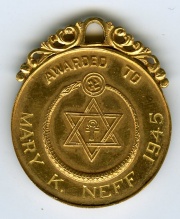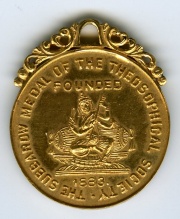Subba Row Medal: Difference between revisions
No edit summary |
No edit summary |
||
| Line 71: | Line 71: | ||
|- | |- | ||
| 1936 | | 1936 | ||
| [[J. | | [[J. Émile Marcault]] | ||
|- | |- | ||
| 1938 | | 1938 | ||
| Line 131: | Line 131: | ||
|- | |- | ||
| 1995 | | 1995 | ||
| [[Hugh | | [[Hugh Shearman]] | ||
|- | |- | ||
| 2010 | | 2010 | ||
Revision as of 22:41, 14 February 2018
In December 27-29, 1883, during the Convention of the Theosophical Society at Adyar instituted the Subba Row Medal, to be awarded to any Theosophical writer producing the best essay on any of the following subjects:
- Aryan Occult Science and Philosophy
- Buddhist Esoteric Philosophy
- Chaldean Esoteric Science and Philosophy and Zoroastrianism
- Jewish Kabbalah and Esoteric Interpretation of the Christian Religion
A fund was established that year to cover the costs of creating a mold and striking the medals. Over the years the medal was no longer awarded for essays, but for major contributions to the body Theosophical literature. The design of the medal shows the Hindu goddess Saraswati on the reverse side, symbolizing knowledge, arts, and music.
In 1891 it was resolved "that the medal be awarded at each Annual Convention to the author of the most valuable contribution of the year to theosophical literature, either by translation into English or by original composition."[1]

